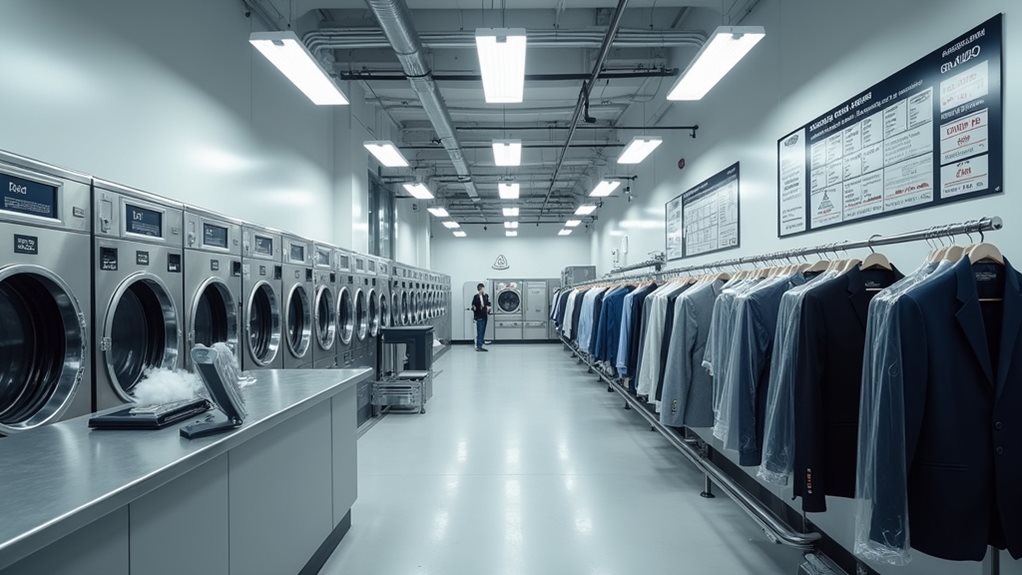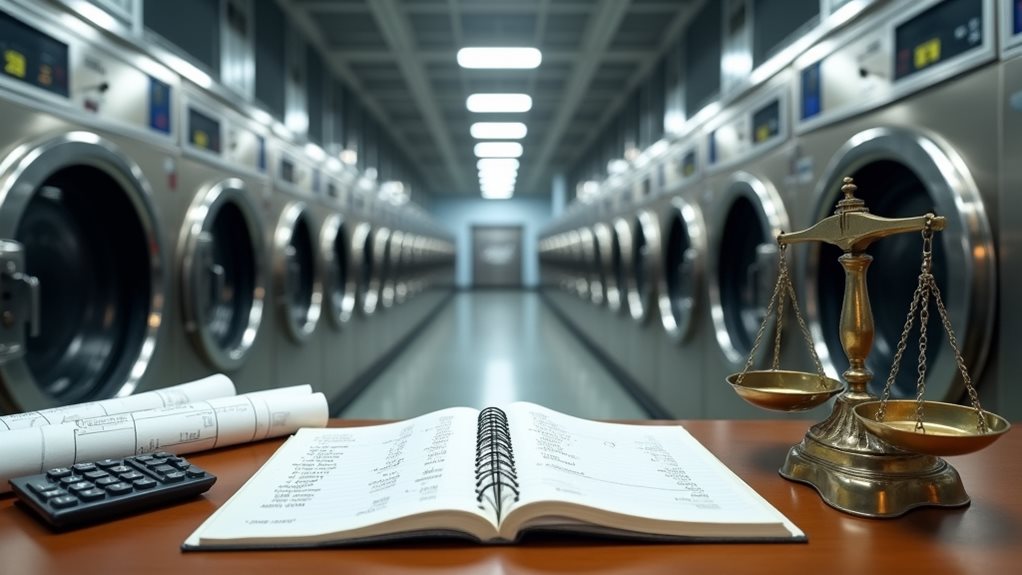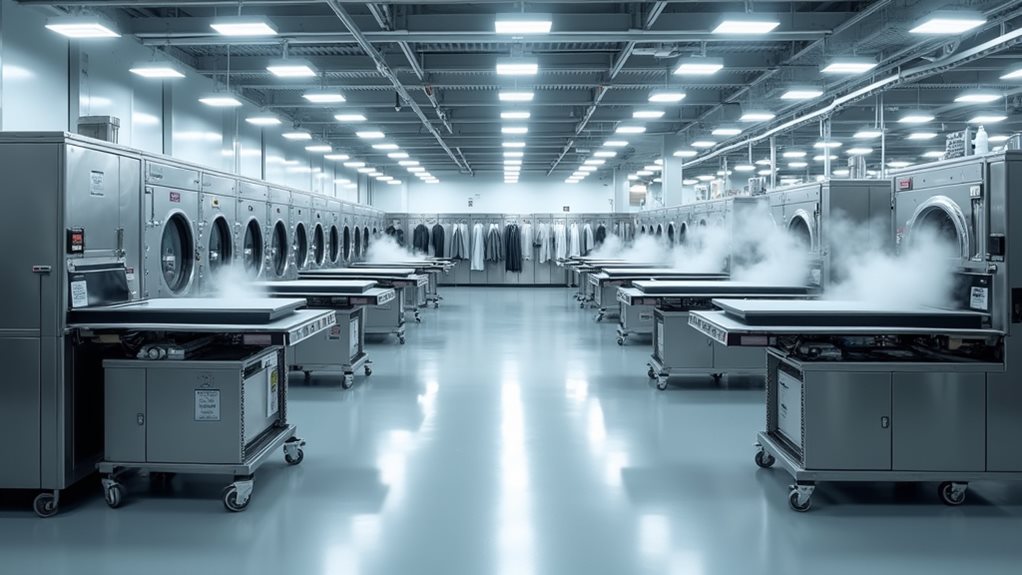You’ll typically earn between $60,000 and $90,000 annually as a dry cleaning owner, though your actual income depends heavily on location, operational efficiency, and customer loyalty – think of it as selling convenience wrapped in clean clothes rather than just cleaning services. Urban locations generally outperform rural ones, while profit margins hover around 5-8% for traditional operations, bumping up to 10% with eco-friendly practices that customers increasingly value. Subscription models and service diversification can boost your bottom line considerably.
Average Annual Earnings for Dry Cleaning Business Owners
The reality of dry cleaning ownership income might surprise you, especially if you’ve been dreaming about the steady cash flow that comes from handling your neighbors’ wrinkled dress shirts and coffee-stained blazers.
The steady cash flow from neighborhood laundry needs isn’t always what aspiring dry cleaning owners expect it to be.
Most dry cleaning business owners earn an average salary between $60,000 to $90,000 annually, though your actual annual earnings depend heavily on operational efficiency and local market demand.
Here’s what I’ve learned from watching countless entrepreneurs in this space: profit margins typically hover around 5-8%, but savvy owners who adopt eco-friendly practices can push that to 10%.
Urban areas consistently outperform rural locations in revenue potential, while subscription-based models can boost your monthly revenue by 15-25%, creating that predictable income stream every business owner craves. 📈
However, you’ll need to factor in substantial startup costs ranging from $200,000 to $500,000 when calculating your potential return on investment.
Key Factors That Impact Owner Profitability

Location isn’t just about real estate—it’s about understanding your customers’ wallets, their laundry habits, and whether they’d rather drive ten minutes to save five dollars or pay premium prices for convenience.
Your dry cleaning business profitability hinges on several interconnected factors that can make or break your average dry cleaner owner salary.
Consider these vital profitability drivers:
- Customer base and location synergy – Urban professionals typically generate higher revenue streams than suburban families.
- Operational costs management – Rent, utilities, and equipment maintenance directly impact your bottom line.
- Service diversification – Blending traditional dry cleaning services with eco-friendly practices boosts customer satisfaction.
- Pricing strategy alignment – Premium locations can support higher prices, while competitive areas require volume-based approaches.
Smart owners recognize that profitability for a dry cleaning operation requires balancing these elements strategically. Well-positioned dry cleaners in high-traffic areas often achieve profit margins of 15-25% annually while building sustainable customer loyalty.
Revenue Streams and Pricing Models in Dry Cleaning

Understanding how money flows through your dry cleaning business starts with recognizing that you’re more than selling cleaning services—you’re selling time, convenience, and peace of mind to customers who’d rather spend their Saturday mornings doing literally anything else than wrestling with stubborn stains.
Your revenue streams extend beyond basic cleaning, with service charges ranging from $3 for shirts to $20 for suits, while additional services like pressing and stain removal add $2-$5 per item.
Smart pricing models include subscription-based packages that boost monthly income by 15-25%, creating customer loyalty while stabilizing cash flow.
I’ve learned that operational efficiency directly impacts profitability—when you streamline processes, those extra minutes translate into dollars that actually matter for your dry cleaning business.
Pricing strategies should also account for geographic location variations, as dry cleaning rates can differ significantly between urban and rural markets, affecting your overall revenue potential.
Operating Expenses and Profit Margins

While generating steady revenue streams feels rewarding, I’ve discovered that managing the expense side of your dry cleaning business is where you’ll either thrive or struggle to keep your doors open.
Your operating costs will make or break those average profit margins, which typically hover around 5-8% for traditional operations.
Here’s what’ll eat into your profits faster than you’d expect:
- Chemical solvents and cleaning equipment that constantly need replacing or maintenance
- Rent, utilities, and staff wages that create your monthly financial foundation
- Equipment breakdowns that always seem to happen at the worst possible moments 😅
- Marketing expenses to maintain customer engagement and build loyalty
Smart operators know that reaching your breakeven point requires servicing about 2,000 pieces monthly.
However, implementing eco-friendly practices and subscription-based models can boost those margins to 10% or higher while delivering high-quality service.
Most successful dry cleaning businesses achieve profit margins between 15-25% when they effectively control equipment costs, chemical supplies, labor, rent, and utilities.
Strategies to Maximize Owner Income and Business Growth

Since you’ve mastered the fundamentals of managing expenses and understanding profit margins, it’s time to shift your focus toward strategic growth initiatives that’ll transform your dry cleaning business from a simple service operation into a thriving, diversified enterprise.
Start by implementing tiered pricing strategies that cater to different customer segments, because one size definitely doesn’t fit all in this industry. Adding additional services like alterations and garment repair can boost your revenue by 15-25% while improving the customer experience considerably.
Consider developing a subscription-based model for regular clients, which creates predictable income streams and builds stronger loyalty programs.
Adopt eco-friendly technologies to slash operational costs by 20%, and leverage data analytics to identify peak times for targeted promotions, ultimately maximizing profitability for a dry cleaning venture focused on sustainable business growth. Understanding your local pricing structures will help you position your services competitively while maintaining healthy profit margins, especially since most Americans already spend between $200 to $500 annually on professional garment care.




